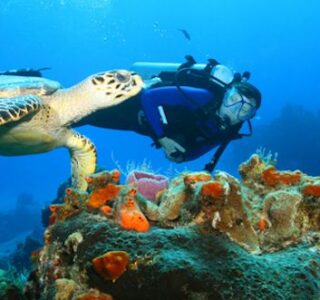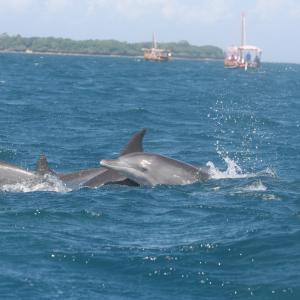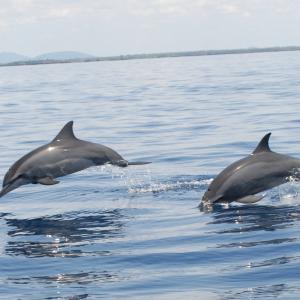``Brilliant Coral Reefs & Countless Dolphins``

This superb marine park is the Masai Mara of the sea – incredible natural formations, colorful habitats and limitless sea life. The Kisite Mpunguti is a protected sanctuary of coral reefs and small islands, home to dolphins, turtles, innumerable fish and sea birds.
The sea life is so lush here that you can expect to see curious dolphins leaping alongside your boat. Enjoy some of the rewarding snorkeling and diving anywhere. The warm, crystalline waters and rainbow coral reefs are a year-round invitation to partake of this outstanding reserve.
Not far from the coastal city of Mombasa, and closer still to Diani beach, visitors can take a dhow cruise to explore the reefs, the islands and the aquatic life of this vibrant reserve.
Created as a marine wilderness to protect the coral gardens and four neighboring islands, the reserve is home to over 45 types of coral and 360 fish species such as grouper, pufferfish, blue-lined snapper, butterfly fish, triggerfish, plus moray eel, turtle and dolphin.
Exploring this colourful aquatic sanctuary, you’ll also find blue parrotfish, octopus, clams, sea cucumbers, reef sharks and sometimes in season (July – December) migrating Humpback whales who nurture their calves in these clear, warm waters.
And then there are the dolphins… the reef habitat shelters over 200 of these lively and friendly cetaceans – spinner, humpback and bottle-nosed. Fortunate visitors can sometimes enjoy a swim with these playful creatures.
The reefs and the protected islands here are home to sea birds living in large nesting colonies. You’ll see the crab-plover and roseate tern.
The Kenyan Barrier Reef
A wonderful feature of this marine environment, this unspoiled coral barrier reef runs quite a distance along the coast. Sometimes referred to as the rainforests of the sea, these ecosystems shelter and provide food for countless marine life.
Along the wall of the reef, just about every nook is inhabited by some sort of aquatic creature. This is a kaleidoscopic underwater world just waiting for your discovery.
This entire protected sanctuary is 39 sq. km (15 sq. mi) in area, with four small islands surrounded by coral reefs.
Location: On the southern coast of Kenya near Shimoni and south of Wasini Island, near the Tanzanian border. Kisite Mpunguti is 120 km (75 mi) from Mombasa and 605 km (375mi) from Nairobi.
Climate: The area here is humid and relatively cool with temperatures of about 22o C (71o F) and annual rainfall 19 inches.
Best time to visit: You can tour, swim and snorkel here all year round. However, the very best time to dive and snorkel is between October and March. The visibility from June through August is not as clear and the seas could be a bit rougher.
Getting there: The park is only reached by boat, usually a cruise on a traditional dhow. You can book a tour with Kenya Randu Tours and Safaris from the coastal resorts of Mombasa and Diani Beach.
Things to do and see
Snorkeling and Diving– With its warm, clear waters and spectacular coral formations, the underwater experience here is one of the best in East Africa. And because of the variety in dive sites – seven in all – there are opportunities for beginners as well as more proficient divers. Diving sites range from 2 m (6 ft) to 32 m (100 ft).
Kisite Island – Surrounded by a beautiful sandy beach, this island is a vital habitat for the various bird populations. In this vital seabird sanctuary, you’ll see colonies of roseate and sooty terns breeding in July.
Turtles – You’re likely to spot plenty of these wonderful land and sea creatures plying through the clear waters. Look for green and hawksbill turtles gracefully swimming or sunning themselves on the rocks.
Shimoni Caves – Located in a small fishing village, these ancient coral caves were for centuries ‘Kayas’ or sacred sites of worship for the local communities. However, fate and history brought a darker aspect to this tranquil spot. In the 18th and 19th century the caves became pens for captured slaves on their way to the slave markets in Zanzibar. Your entrance fee will help pay the salaries of local teachers and school fees for children in need.


